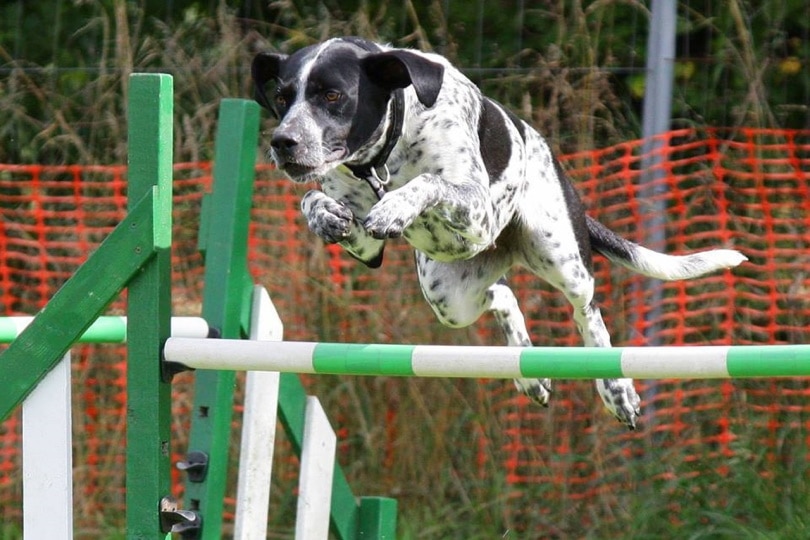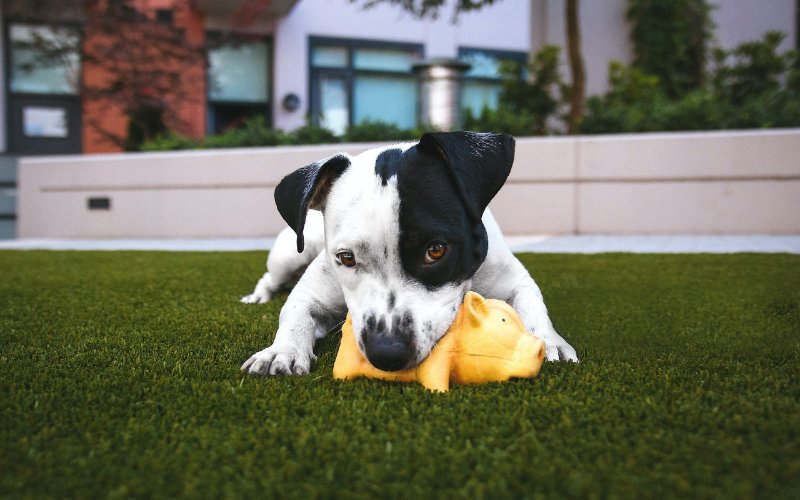Getting a new puppy is an exciting time for any owner but also full of challenges. After an initial period of settling in, you will want to start socializing your new addition, and the earlier you can start basic training, the better your chances of having a well-behaved dog. You need to ensure they’re happy and healthy, too, while ensuring that your pup forms close bonds with family members.
Playing games can be an effective way to develop the skills your dog needs in life. It allows you to teach some basic commands, lets them burn off energy while building muscle and stamina, and will develop a bond between you both.
However, which games are suitable and which ones will you both enjoy? Below are 11 great puppy games you can play with your new dog.
The 11 Puppy Games You Can Play With Your New Dog
1. Fetch

It’s a timeless classic, and for good reason. Fetch encourages your dog to run around and introduces the recall command. If you use a favorite toy, it can also teach your dog to let go of items and encourage them to share.
Initially, fetch can seem like a chore. You have to start with a small toy that is soft, easy to carry, and doesn’t pose a choking hazard. You will likely have to accompany your dog as they approach the toy and then reward and praise them when they come back with the object.
Over time, and encouraged by your enthusiastic praise, your puppy will learn the routine, and you won’t have to be quite as involved in the process. You can also increase the distance you throw and the size of the item, but it should never be so large that it’s a struggle to carry.
2. Find the Toy
Dogs understand the concept of object permanence, which means they know that when something is put out of sight, it still exists. That’s how they know their favorite toy you put away is in the cupboard under the stairs. However, they need some help developing these instincts, and searching for the toy is a great way to encourage this behavior.
Get a toy you know your dog likes and find somewhere to hide it. Initially, you should do this with your dog watching. Make sure part of the toy is still visible. For example, you can half-cover the toy with a blanket or towel. You will need to encourage them to go and find the toy and provide plenty of praise when they are successful.
As their skills improve, you can find increasingly cunning places to hide the toy, but most dogs will get bored of the game if it is too difficult.
3. Hide & Seek
Hide and seek enables you to teach a dog their name as well as a recall command like “come.” It also encourages the sit-and-stay commands, and with plenty of encouragement and praise, you will see how much they enjoy the game by the wagging of their tail and the excitement in their eyes when they find you.
Initially, you will need two people to play this game effectively. Have somebody hold the dog while you go and hide. Once hidden, call their name or use the “come” command and have the other person let them go. Over time, you can introduce the stay command, so it becomes a one-person game. Have different people play the game and use the dog’s name to teach them.
4. Find the Treats
You’ve already hidden toys and yourself, but this game uses tasty treats. Use something your puppy recognizes the smell of, and start easy before building up to a more taxing challenge. Initially, have somebody hold the dog while you “hide” the treat. Ensure it is partially visible and easy to find, and use the “find it” command when you let them loose.
They will use their senses of smell and sight to find the treat. Over time, you can hide the treat somewhere the dog can’t see, and eventually, you should even be able to play the canine equivalent of “chase the lady” by hiding the treat under one of two or three cups and having them choose the right one.
5. Jump

Many breeds grow to love agility courses. While you can’t expect a 3-month-old puppy to be able to take on multiple jumps, ramps, tunnels, and slaloms just yet, you can introduce them to the concept. It’s also an excellent way to help them get used to being on a leash and not hating the experience.
Set up a small hurdle, put your dog on the leash, and run and hop over it. Over time, you can add additional hurdles while increasing their size. You can also teach the dog to tackle the jump independently while you walk alongside.
6. Puzzle Toys
Puzzle toys, such as treat-stuffed Kongs, encourage positive activities and teach multiple lessons to your dog. They encourage logical thought and require your dog to use their sense of smell. They are solo games that don’t require or benefit from human input, although you may need to show a young puppy what to do.
Supervise your young puppy with the toy initially to ensure that they don’t injure themselves or break anything and to make sure the puzzle isn’t too taxing.
7. Frisbee

As your puppy ages, you can introduce more challenging games and ramp up the difficulty of those you already enjoy. Frisbee is essentially a game of fetch, but it involves a flying disc-shaped object that can be thrown further and poses a greater challenge for your dog.
You can start with a foam disc, which is softer and less dangerous than a hard plastic one, and start throwing it a short distance before increasing the range over time. You will likely need a large, open space for this game, as well as excellent recall skills.
8. Tug of War
Tug of War gets some bad press as a dog game, but it can help puppies strengthen their teeth and build muscle while mimicking hunting techniques they would have used in the wild. It’s also a lot of fun, but you must set clear ground rules from the beginning.
Do not let your dog encourage you to play this game by pulling on hands or clothing; make sure you initiate the game. Choose the tug-of-war toy carefully, and if you use a toy made with rope, remove it after the game; otherwise, your pup could end up eating the strands of rope and suffering gastrointestinal problems.
Don’t pull too hard or swing your dog around by the toy. Finally, let your dog win occasionally; otherwise, it will become frustrating and can cause anxiety.
9. Sprinkler Games
Some dogs love water. Some dogs hate it. But if you ever need to wash a dirty dog, you will want yours to at least tolerate it. Sprinkler games are not only a refreshing form of entertainment for the summer months, but if you start when your pup is young, they will become accustomed to getting splashed and wet. You can get sprinklers for dogs and doggy paddling pools if you don’t want to use your own or don’t have anything suitable.
Don’t force your dog into the water if they are stressed or anxious. Alternatively, you can turn the sprinkler on, play fetch, or chase your dog through the water. You can also fill the paddling pool with a small amount of water and throw a toy or ball in to play chase. You can increase the water level over time.
10. Agility Courses
As your dog gets older and develops more physical skills and athleticism, you can start to create your own agility courses. You can place hurdles in your yard, set up a box or table they need to jump on, or install agility tunnels and slaloms.
Each of the individual elements of an agility course can be helpful in other areas of your dog’s life. For example, jumping on the table is similar to jumping in the trunk of a car or even on the vet’s table.
Eventually, you can sign up for dog agility classes that are more advanced and structured than your own efforts.
11. Chase

Chase is a relatively simple concept, but it can be used to teach good behavior, and you can add extra elements that improve your dog’s skills. This is another game where you need to let your puppy win from time to time to avoid anxiety, and although some excitable jumping is to be expected, you can use the game to teach that scratching and nipping are not acceptable forms of behavior.

How Much Should You Play With a New Puppy?
Generally speaking, you should provide a puppy with at least 30 minutes of structured exercise each day and play for at least 20 to 30 minutes. Not only can you use this time to teach vital skills, but it allows you to bond, and it will wear your pup out. A tired puppy will not engage in destructive behavior, such as chewing furniture or eating shoes. If you notice this kind of behavior in your puppy and exercise doesn’t seem to help, ask a veterinarian for their advice.
If you need to speak with a vet but can't get to one, head over to PangoVet. It's our online service where you can talk to a vet online and get the advice you need for your pet — all at an affordable price!


Conclusion
A puppy can make a fascinating addition to any family, but you need to ensure that you meet all of their needs. As well as keeping them healthy and properly fed, you must provide entertainment and physical and mental stimulation. You will both benefit from playing games, and you should aim to play for around 30 minutes each day, progressively increasing the challenge of the games you play.
You might also like:
Featured Image Credit: Justin Veenema, Unsplash




















